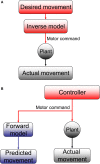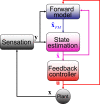Forward models and state estimation in compensatory eye movements
- PMID: 19956563
- PMCID: PMC2786296
- DOI: 10.3389/neuro.03.013.2009
Forward models and state estimation in compensatory eye movements
Abstract
The compensatory eye movement (CEM) system maintains a stable retinal image, integrating information from different sensory modalities to compensate for head movements. Inspired by recent models of the physiology of limb movements, we suggest that CEM can be modeled as a control system with three essential building blocks: a forward model that predicts the effects of motor commands; a state estimator that integrates sensory feedback into this prediction; and, a feedback controller that translates a state estimate into motor commands. We propose a specific mapping of nuclei within the CEM system onto these control functions. Specifically, we suggest that the Flocculus is responsible for generating the forward model prediction and that the Vestibular Nuclei integrate sensory feedback to generate an estimate of current state. Finally, the brainstem motor nuclei - in the case of horizontal compensation this means the Abducens Nucleus and the Nucleus Prepositus Hypoglossi - implement a feedback controller, translating state into motor commands. While these efforts to understand the physiological control system as a feedback control system are in their infancy, there is the intriguing possibility that CEM and targeted voluntary movements use the same cerebellar circuitry in fundamentally different ways.
Keywords: cerebellum; control systems; eye movements; forward model; model; okr; vestibular nucleus; vor.
Figures








Similar articles
-
A Neuroanatomically Grounded Optimal Control Model of the Compensatory Eye Movement System in Mice.Front Syst Neurosci. 2020 Mar 25;14:13. doi: 10.3389/fnsys.2020.00013. eCollection 2020. Front Syst Neurosci. 2020. PMID: 32269516 Free PMC article.
-
Fuzzy neuronal model of motor control inspired by cerebellar pathways to online and gradually learn inverse biomechanical functions in the presence of delay.Biol Cybern. 2017 Dec;111(5-6):421-438. doi: 10.1007/s00422-017-0735-9. Epub 2017 Oct 9. Biol Cybern. 2017. PMID: 28993878
-
Discharge patterns in nucleus prepositus hypoglossi and adjacent medial vestibular nucleus during horizontal eye movement in behaving macaques.J Neurophysiol. 1992 Jul;68(1):319-32. doi: 10.1152/jn.1992.68.1.319. J Neurophysiol. 1992. PMID: 1517825
-
Dysmetria and Errors in Predictions: The Role of Internal Forward Model.Int J Mol Sci. 2020 Sep 20;21(18):6900. doi: 10.3390/ijms21186900. Int J Mol Sci. 2020. PMID: 32962256 Free PMC article. Review.
-
[Central oculomotor circuits].Rev Neurol (Paris). 1985;141(5):349-70. Rev Neurol (Paris). 1985. PMID: 3901182 Review. French.
Cited by
-
Reward-Based Improvements in Motor Control Are Driven by Multiple Error-Reducing Mechanisms.J Neurosci. 2020 Apr 29;40(18):3604-3620. doi: 10.1523/JNEUROSCI.2646-19.2020. Epub 2020 Mar 31. J Neurosci. 2020. PMID: 32234779 Free PMC article.
-
Internal models for interpreting neural population activity during sensorimotor control.Elife. 2015 Dec 8;4:e10015. doi: 10.7554/eLife.10015. Elife. 2015. PMID: 26646183 Free PMC article.
-
Cerebellum anatomy predicts individual risk-taking behavior and risk tolerance.Neuroimage. 2022 Jul 1;254:119148. doi: 10.1016/j.neuroimage.2022.119148. Epub 2022 Mar 26. Neuroimage. 2022. PMID: 35346839 Free PMC article.
-
The Cerebellum: Adaptive Prediction for Movement and Cognition.Trends Cogn Sci. 2017 May;21(5):313-332. doi: 10.1016/j.tics.2017.02.005. Epub 2017 Apr 3. Trends Cogn Sci. 2017. PMID: 28385461 Free PMC article. Review.
-
Rebuilding cerebellar network computations from cellular neurophysiology.Front Cell Neurosci. 2010 Nov 4;4:131. doi: 10.3389/fncel.2010.00131. eCollection 2010. Front Cell Neurosci. 2010. PMID: 21103017 Free PMC article. No abstract available.
References
LinkOut - more resources
Full Text Sources

